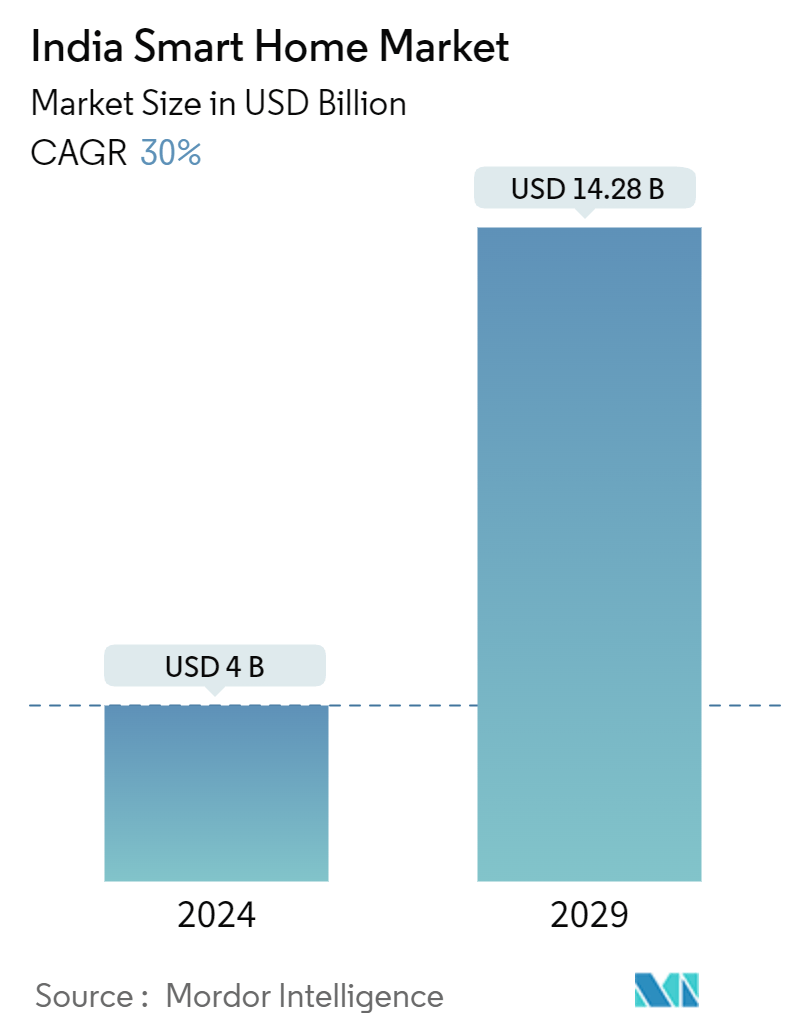Market Size of India Smart Home Industry

| Study Period | 2019 - 2029 |
| Base Year For Estimation | 2023 |
| Market Size (2024) | USD 4 Billion |
| Market Size (2029) | USD 14.28 Billion |
| CAGR (2024 - 2029) | 30.00 % |
| Market Concentration | Low |
Major Players
*Disclaimer: Major Players sorted in no particular order |
India Smart Home Market Analysis
The India Smart Home Market size is estimated at USD 4 billion in 2024, and is expected to reach USD 14.28 billion by 2029, growing at a CAGR of 30% during the forecast period (2024-2029).
- The Indian smart home market is changing rapidly. Smart homes are mainly advertised as residences with high-tech security capabilities. The market is expanding to include innovations such as fire alarms, entertainment systems, lighting systems, gas leak detectors, and energy-efficient products. In addition to improved security, convenience, and comfort, smart homes also offer substantial energy savings.
- The primary driver for the urban Indian population adopting smart homes is the focus on security. Approximately 50% of customers interested in smart homes are motivated by their security features. Energy management is becoming increasingly popular in smart homes with the increasing emphasis on environmental issues. Utilizing smart lighting systems, energy-saving appliances, and programmable thermostats can assist homeowners in maximizing their energy efficiency. For instance, in April 2024, Signify Innovations India Ltd aimed to increase its revenue from the smart lighting business by establishing 200 Philips Smart Light Hubs across the country within the next two to three years.
- With the growing issues about energy conservation, consumers are looking for ways to reduce energy consumption in homes. Smart home devices, such as energy-efficient lighting and smart thermostats, help optimize energy usage. Moreover, government initiatives promoting sustainable development and digitalization, such as the smart cities mission, are driving the adoption of smart home solutions in India.
- Growing concerns about data privacy and cybersecurity are significant barriers to smart home adoption in India. Consumers are aware of the potential risks combined with connected devices, such as hacking and unauthorized access to personal information. The rising popularity of smart home devices is leading to a higher level of worry and an increase in the number of issues encountered. The expansion of connected devices also brings new risks and weaknesses, highlighting the importance of thorough security measures and device safeguards.
- Macroeconomic factors like rapid urbanization in India lead to the construction of more residential buildings, providing opportunities for integrating smart home technologies in new constructions. In addition, technological advancements such as the proliferation of smartphones and high-speed internet connectivity create a conducive environment for adopting smart home solutions in India.
India Smart Home Industry Segmentation
For market estimation, the revenue generated from the sale of smart home devices offered by different market players for a diverse range of applications is tracked. Market trends are evaluated by analyzing investments made in product innovation, diversification, and expansion. Further, advancements in technology are crucial in determining the growth of the market studied.
The Indian smart home market is segmented by product type (comfort and lighting, control and connectivity, energy management, home entertainment, security, smart appliances, HVAC control) and technology (Wi-Fi, Bluetooth, and other technologies). The market sizes and forecasts are provided in terms of value (USD) for all the above segments.
| By Product Type | |
| Comfort and Lighting | |
| Control and Connectivity | |
| Energy Management | |
| Home Entertainment | |
| Security | |
| Smart Appliances | |
| HVAC Control |
| By Technology | |
| Wi-Fi | |
| Bluetooth | |
| Other Technologies |
India Smart Home Market Size Summary
The Indian smart home market is experiencing rapid transformation, driven by advancements in technology and increasing consumer demand for enhanced security, convenience, and energy efficiency. Smart homes in India are evolving beyond basic security features to include a wide range of innovations such as fire alarms, entertainment systems, and energy-efficient products. The urban population's primary motivation for adopting smart home solutions is the focus on security, with a growing interest in energy management due to environmental concerns. Government initiatives like the smart cities mission further promote the adoption of smart home technologies, encouraging consumers to integrate energy-saving appliances and smart lighting systems into their homes. The market is also witnessing significant developments in smart lighting, which offers benefits such as energy efficiency, enhanced security, and improved convenience through remote control and automation features.
The competitive landscape of the Indian smart home market is characterized by the presence of both small and large players, with major companies like Schneider Electric, Emerson Electric, ABB, Honeywell, and Siemens holding significant market shares. These companies are actively expanding their consumer base through collaborations, partnerships, and product innovations. The market is also benefiting from macroeconomic factors such as rapid urbanization and technological advancements like the proliferation of smartphones and high-speed internet connectivity. However, challenges such as data privacy and cybersecurity concerns pose barriers to widespread adoption. Despite these challenges, the market is poised for substantial growth, with smart home solutions becoming increasingly accessible and integrated into new residential constructions across India.
India Smart Home Market Size - Table of Contents
-
1. MARKET INSIGHTS
-
1.1 Market Overview
-
1.2 Industry Attractiveness - Porter's Five Forces Analysis
-
1.2.1 Threat of New Entrants
-
1.2.2 Bargaining Power of Buyers/Consumers
-
1.2.3 Bargaining Power of Suppliers
-
1.2.4 Threat of Substitute Products
-
1.2.5 Intensity of Competitive Rivalry
-
-
1.3 Technology Snapshot
-
1.4 Impact of COVID-19 Aftereffects and Other Macroeconomic Factors on the Market
-
-
2. MARKET SEGMENTATION
-
2.1 By Product Type
-
2.1.1 Comfort and Lighting
-
2.1.2 Control and Connectivity
-
2.1.3 Energy Management
-
2.1.4 Home Entertainment
-
2.1.5 Security
-
2.1.6 Smart Appliances
-
2.1.7 HVAC Control
-
-
2.2 By Technology
-
2.2.1 Wi-Fi
-
2.2.2 Bluetooth
-
2.2.3 Other Technologies
-
-
India Smart Home Market Size FAQs
How big is the India Smart Home Market?
The India Smart Home Market size is expected to reach USD 4 billion in 2024 and grow at a CAGR of 30% to reach USD 14.28 billion by 2029.
What is the current India Smart Home Market size?
In 2024, the India Smart Home Market size is expected to reach USD 4 billion.

